When your cat is experiencing severe nausea or vomiting, it can be distressing.
You want to provide relief quickly, and this is where ondansetron comes in. Vets often prescribe this medication to help alleviate these uncomfortable symptoms in cats, especially those dealing with serious conditions like cancer or kidney disease.
Understanding how ondansetron works and knowing when to use it can significantly improve your cat’s quality of life.
It selectively targets serotonin receptors that can trigger nausea, making it a useful tool in your veterinary arsenal.
As you read further, you’ll uncover important information about dosages, potential side effects, and precautions to consider before administering this medication.
Whether you’re a seasoned pet owner or new to the journey, being informed will help you make the best decisions for your feline friend.
By recognizing the signs of distress in your cat and knowing when ondansetron can provide relief, you can navigate your pet’s health challenges with confidence.
Key Takeaways
- Ondansetron is effective for treating nausea and vomiting in cats.
- Proper dosage and administration are crucial for safety and efficacy.
- Being aware of side effects ensures better health management for your cat.
Understanding Ondansetron
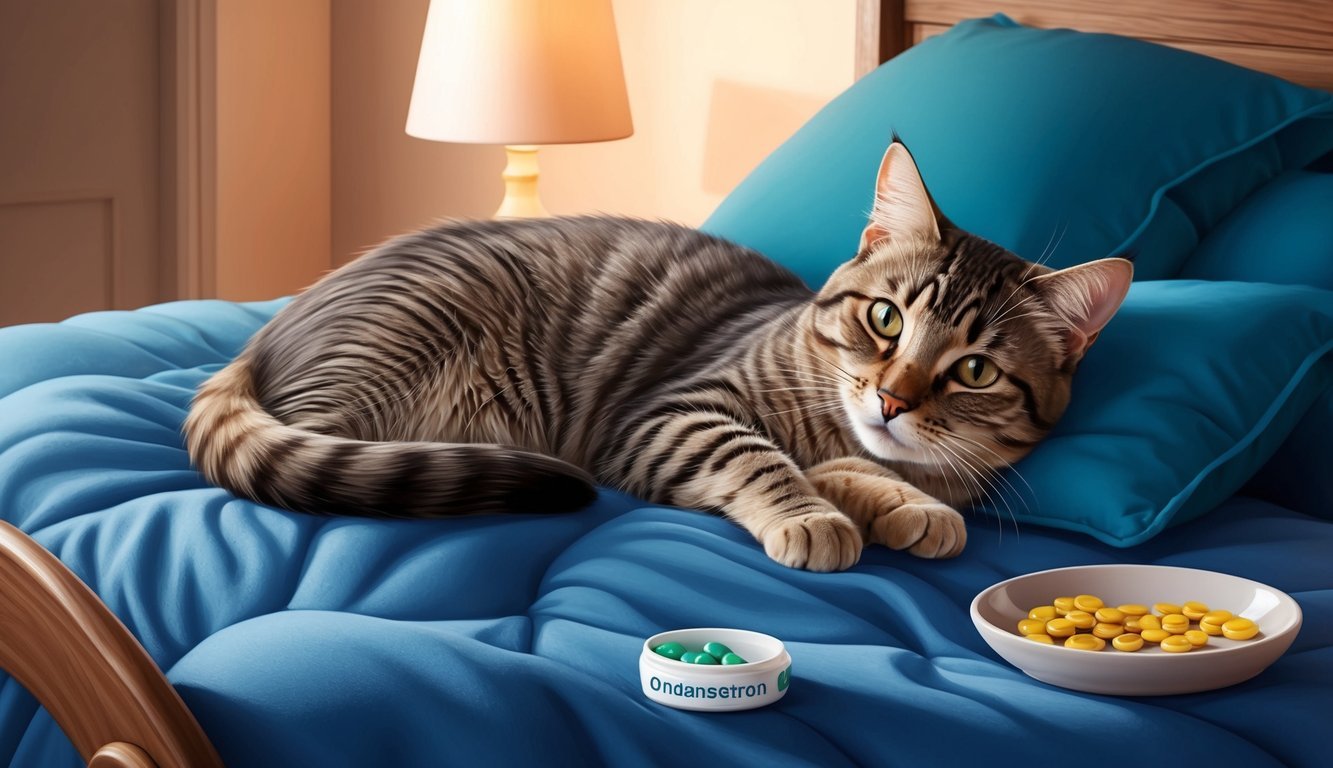
Ondansetron is a medication frequently used to manage nausea and vomiting in various situations.
It’s crucial to understand how this drug works, the different forms it comes in, and its regulatory status for pets like cats.
Mechanism of Action
Ondansetron functions primarily as an antiemetic by blocking serotonin receptors, particularly the 5-HT3 receptors, in the brain and gastrointestinal tract.
These receptors are connected to the chemoreceptor trigger zone, which plays a pivotal role in inducing vomiting.
By inhibiting serotonin, ondansetron effectively reduces the sensation of nausea and prevents vomiting.
This mechanism is valuable for cats facing nausea due to chemotherapy or other health issues.
Ondansetron Forms
You can find ondansetron in several forms to suit your cat’s needs.
Commonly available formats include:
- Oral Solution: This liquid form allows for easy administration, especially for reluctant eaters.
- Oral Disintegrating Tablet (Zuplenz): These tablets dissolve quickly in the mouth, making them a convenient option for pets.
- Injection: Veterinarians may administer ondansetron via injection in clinical settings when oral delivery is not feasible.
Each form has its unique advantages, depending on your cat’s situation and preferences.
FDA Approval and Off-Label Use
Ondansetron is FDA-approved for use in humans, particularly for chemotherapy-induced nausea.
In veterinary medicine, it’s commonly used off-label for treating nausea and vomiting in cats.
Your veterinarian can determine the appropriate dosage, typically around 0.11 mg per pound every 8 to 12 hours.
Always consult your vet before administering ondansetron to ensure it’s safe and effective for your cat’s specific condition.
Off-label use is common in veterinary practices when existing medications do not provide relief.
When to Use Ondansetron for Cats
Understanding when to use ondansetron for your cat can make a significant difference in their comfort and recovery.
This medication serves as an effective solution for specific conditions related to nausea and vomiting.
Common Uses in Cats
Ondansetron is often prescribed for cats experiencing severe nausea or vomiting due to various reasons.
It’s particularly effective in cats undergoing chemotherapy or radiation therapy, which can trigger significant discomfort.
It can also benefit cats post-surgery, helping manage nausea caused by anesthesia.
If your cat has chronic kidney disease, ondansetron may alleviate nausea linked to that condition.
Typical symptoms you might notice include:
- Excessive drooling
- Reluctance to eat
- Rapid or constant vomiting
Always consult your veterinarian when you observe these signs, as they can determine if ondansetron is appropriate for your cat’s situation.
Ondansetron vs. Other Antiemetics
While ondansetron is a commonly used antiemetic, it’s essential to consider how it compares to other options.
For instance, maropitant is another medication used effectively for nausea and vomiting in cats.
Metoclopramide is also an option, often used for gastrointestinal issues, but may not be suitable for all cases.
Ondansetron generally targets the causes of vomiting related to chemotherapy and other severe conditions effectively.
Each medication has its benefits and side effects.
Discuss with your vet to decide which one aligns best with your cat’s needs and conditions.
Understanding these options can help you make an informed choice for your pet’s health.
Dosage and Administration
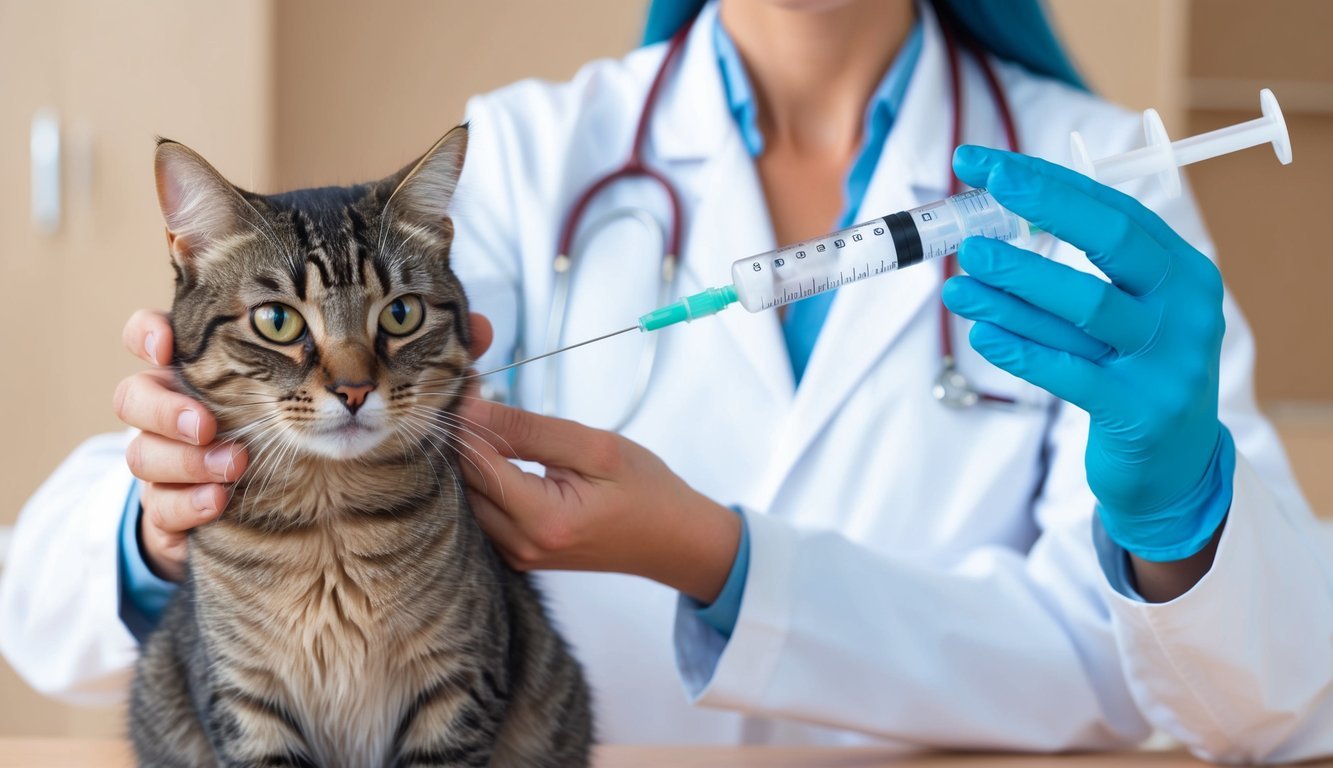
Understanding the proper dosage and how to administer ondansetron to your cat is essential for effective treatment.
This section covers how to determine the right dose and the methods of administration you can use.
Determining the Right Dose
The standard dosage of ondansetron for cats is 0.11 mg per pound (about 0.22 mg/kg) of body weight.
This dosage is typically administered every 8 to 12 hours.
Your veterinarian may adjust this based on your cat’s specific condition.
Always consult your vet before changing the dosage.
It’s crucial to measure the dose accurately, especially when using oral tablets or liquid formulations.
For instance, if your cat weighs 10 pounds, the calculation would be:
- 10 lbs × 0.11 mg/lb = 1.1 mg of ondansetron.
Keep track of your cat’s response to the medication, and report any side effects to your vet immediately.
Methods of Administration
Ondansetron can be given to cats in different ways, depending on what your veterinarian prescribes.
Here are the main methods:
-
Oral Tablets: These can be administered directly or hidden in food. Ensure your hands are dry when handling these tablets, especially if they dissolve easily.
-
Liquid Formulation: Use a syringe for liquid doses to ensure accuracy. Measure carefully and, if your cat vomits when dosed on an empty stomach, try giving the next dose with food.
-
Injection: In some cases, your veterinarian may recommend or administer an injectable form, especially for cats that resist oral medications.
Always follow your vet’s instructions on how and when to give the medication.
Potential Side Effects and Precautions
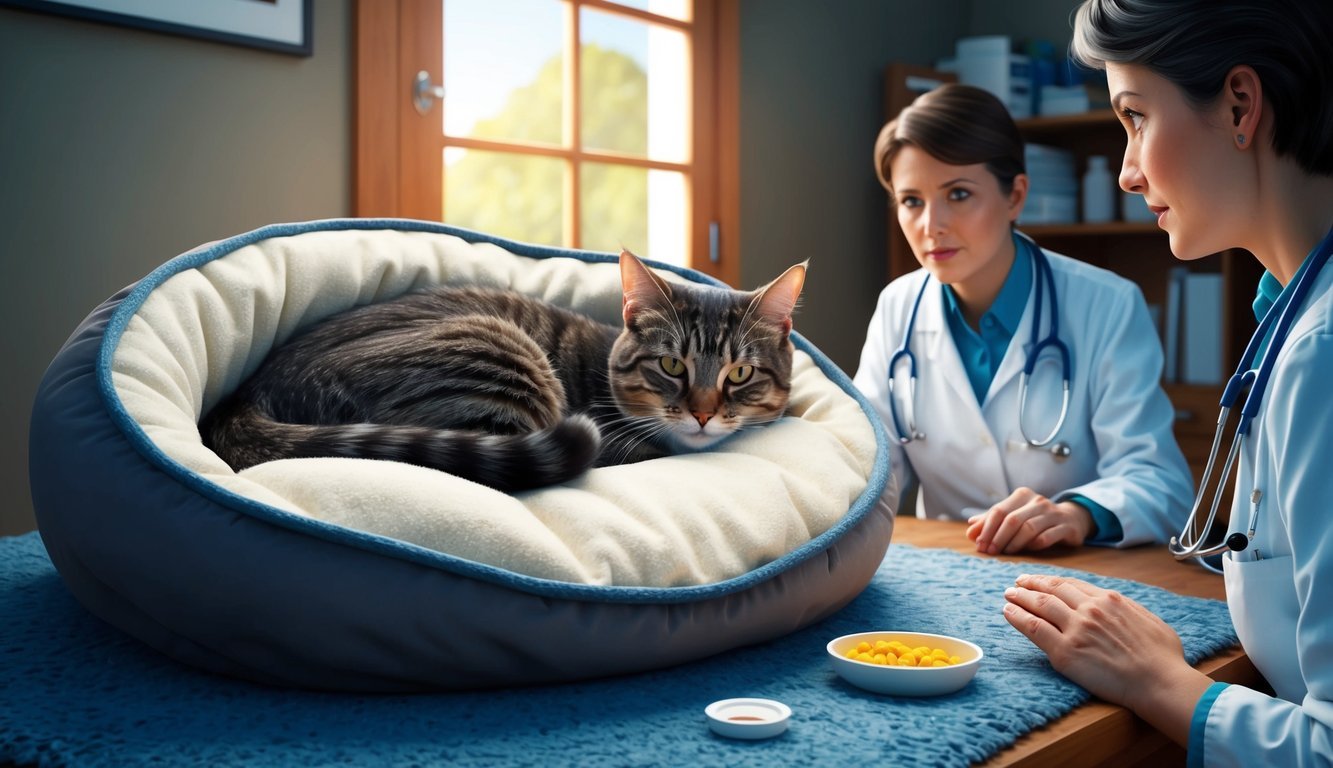
When considering ondansetron for your cat, it’s essential to be aware of the potential side effects and precautions that come with this medication.
Understanding these aspects will help ensure your cat’s safety and well-being.
Common Side Effects
Ondansetron may cause several common side effects in cats.
These often include:
- Constipation: Some cats may experience difficulty passing stools.
- Diarrhea: Conversely, others may have loose stools.
- Drowsiness: Sedation can occur, leading to increased sleepiness.
While these effects are usually mild and might resolve on their own, it’s still important to monitor your cat.
Changes in appetite or behavior should be noted as well.
If symptoms persist or worsen, consulting your veterinarian is strongly recommended.
Serious Concerns and Contraindications
In rare instances, ondansetron can lead to severe side effects.
Serious warnings include:
- Abnormal Heart Rhythms: Arrhythmias can pose significant health risks, so any irregular heartbeat should be evaluated.
- Low Blood Pressure: This condition can lead to fainting or lethargy.
Precautions are particularly crucial for cats with pre-existing conditions.
If your cat has chronic kidney disease or liver disease, or is on certain heart medications, extra caution is warranted.
Additionally, allergic reactions, though rare, may manifest as difficulty breathing or swelling of the face.
Consult your veterinarian to assess suitability based on your cat’s health profile.
Drug Interactions

When using ondansetron for your cat, it’s vital to be aware of potential drug interactions.
Certain medications can either increase the risk of side effects or decrease the effectiveness of ondansetron.
This section highlights common drug interactions and symptoms to watch for, so you can keep your feline friend safe.
Common Drug Interactions
Ondansetron can interact with several medications, impacting how they work in your cat’s body.
Here are a few notable examples:
- Tramadol: This pain reliever can enhance sedation when used with ondansetron. Monitor for excessive drowsiness in your cat.
- Apomorphine: Used to induce vomiting, combining this with ondansetron may lead to unpredictable effects. Close observation is essential.
- Cyclophosphamide: If your cat is undergoing chemotherapy with this drug, ondansetron may alter its effectiveness and lead to changes in side effects.
Always consult your veterinarian about any other medications your cat is taking, even over-the-counter products.
Symptoms of Interaction and Monitoring
Be vigilant for symptoms that indicate a possible drug interaction.
You should look for:
- Increased drowsiness or lethargy
- Changes in appetite or gastrointestinal issues
- Unusual agitation or restlessness
Regular check-ins with your veterinarian can help manage any potential problems.
They may suggest periodic blood tests or adjustments to your cat’s medication regimen.
Keeping a detailed medication list is a good practice.
Share this with your veterinary care team to ensure they’re fully informed.
This proactive approach can help minimize risks while your cat benefits from ondansetron.
Storing and Handling Ondansetron
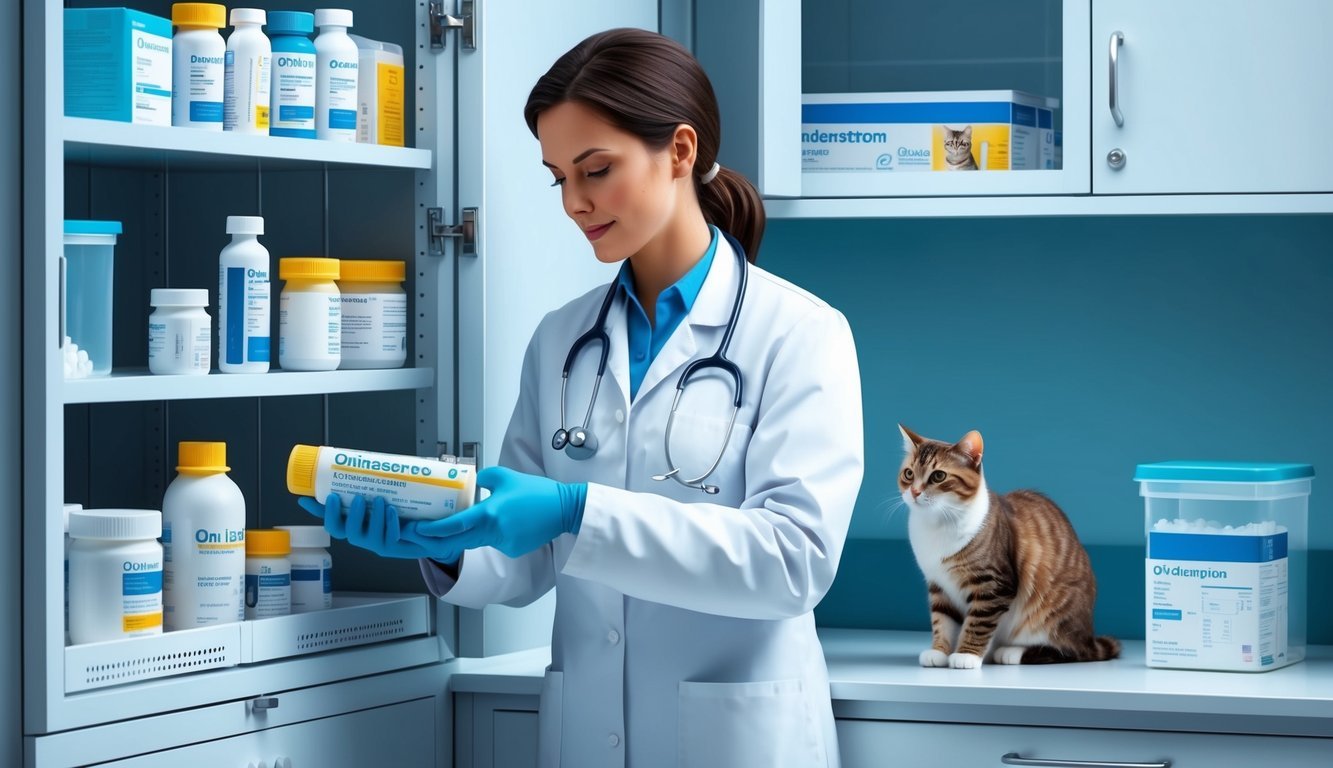
Proper storage and handling of ondansetron are essential to ensure its effectiveness and safety in treating your cat.
Here’s what you need to know to keep this prescription medication safe.
Storage Recommendations
Store ondansetron at room temperature, ideally between 36°F to 86°F (2°C to 30°C).
Make sure the medication is kept in a closed container to protect it from moisture and light.
Avoid areas with high humidity, like bathrooms, as these can affect the drug’s stability.
Always check the expiration date before use.
Do not use ondansetron beyond this date.
If you’re unsure, consult your veterinarian for guidance.
Keep the medication out of reach of pets and children.
A locked cabinet is a good choice for safety, ensuring that your cat cannot accidentally ingest any leftover pills or liquids.
Safe Handling Practices
When you handle ondansetron, keep your hands dry, especially if you’re dealing with tablets that dissolve easily.
To avoid contamination, wash your hands before and after administration.
If the medication is liquid, measure it carefully to ensure your cat receives the correct dosage.
Use a proper measuring device, like a syringe or a dosing spoon, for accuracy.
If you notice any unusual reactions in your cat after administering ondansetron, contact your veterinarian immediately.
It’s crucial to monitor your cat closely, especially with new medications.
Alternative Treatments for Nausea and Vomiting
When your cat experiences nausea or vomiting, exploring alternative treatments can be beneficial.
These options may complement or serve as alternatives to medications like ondansetron, offering you various pathways to help your feline friend.
Natural Remedies
Natural remedies can be effective for managing your cat’s nausea.
Ginger is a popular choice, known for its anti-inflammatory and antiemetic properties.
You can find ginger supplements made specifically for pets, or you can add small amounts of ginger to their food.
Another option is CBD oil, which is gaining traction among pet owners for its potential to ease nausea and improve appetite.
Acupuncture may also be a holistic alternative.
It can help alleviate nausea by stimulating specific points on your cat’s body, promoting overall well-being.
Always consult your veterinarian before trying any new treatment to ensure it’s safe and appropriate for your cat’s specific condition.
Recognizing an Emergency: Overdose and Reactions
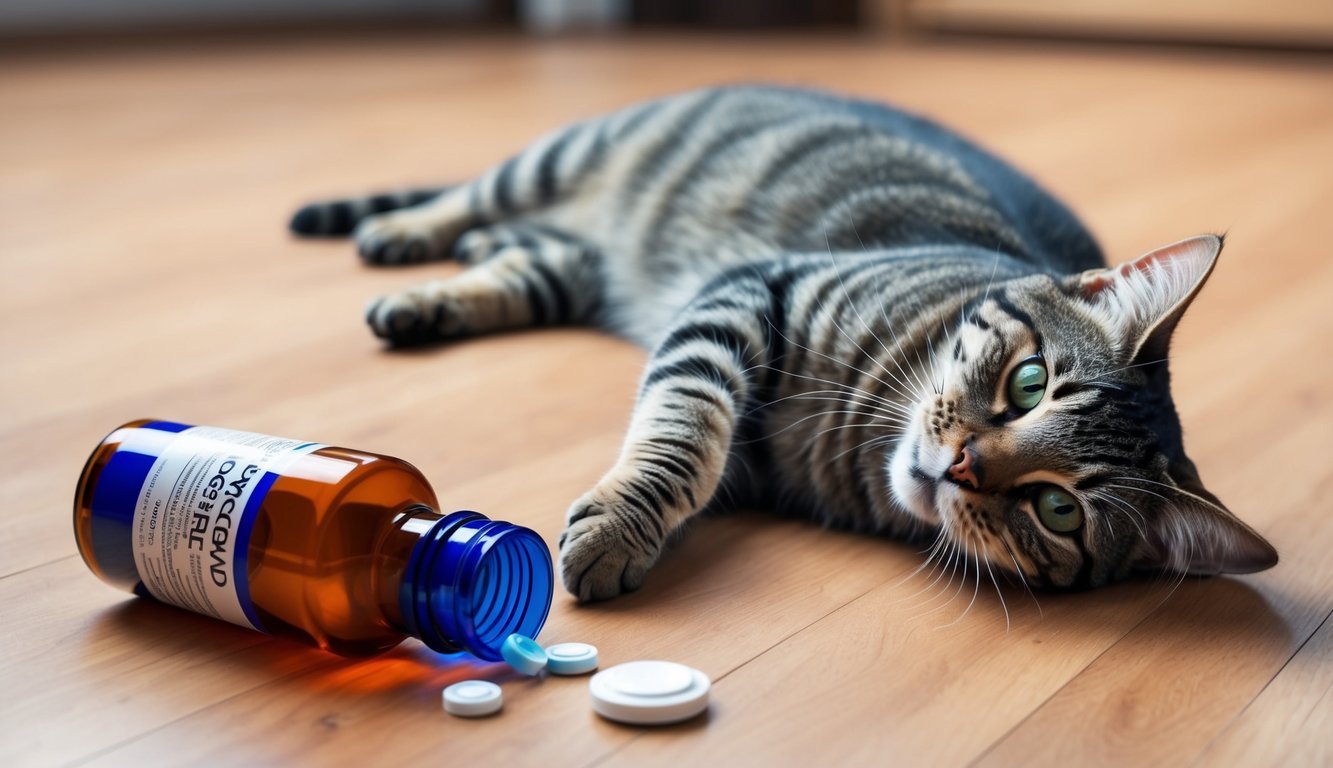
Being aware of the signs of an ondansetron overdose in your cat is essential for ensuring their safety.
Quick recognition and prompt action can significantly alter the outcome.
Signs of Ondansetron Overdose
If your cat has ingested too much ondansetron, you might notice several alarming symptoms.
Key signs include:
- Drowsiness: An unusual level of lethargy can indicate a problem.
- Shallow Breathing: Watch for changes in your cat’s breathing patterns.
- Head Shaking: This can signal discomfort or distress.
- Vomiting: While ondansetron is meant to curb vomiting, paradoxical reactions can occur.
Always monitor your pet closely after any medication administration.
If you observe one or more of these symptoms, it could mean an emergency situation.
Immediate Actions and Veterinary Care
If you suspect an overdose, act swiftly.
The first step is to contact your veterinarian immediately.
Provide them with as much detail as possible, including:
- Amount Ingested: Know the number of tablets or the volume of liquid your cat has taken.
- Time of Ingestion: This can help the vet determine the best course of treatment.
While waiting for professional help, do not induce vomiting unless instructed to do so by your vet.
Arriving at the clinic or emergency facility promptly will allow veterinary staff to assess your cat’s condition.
They may perform tests and provide supportive care, such as intravenous fluids or medications to counteract the effects of the overdose.
Frequently Asked Questions
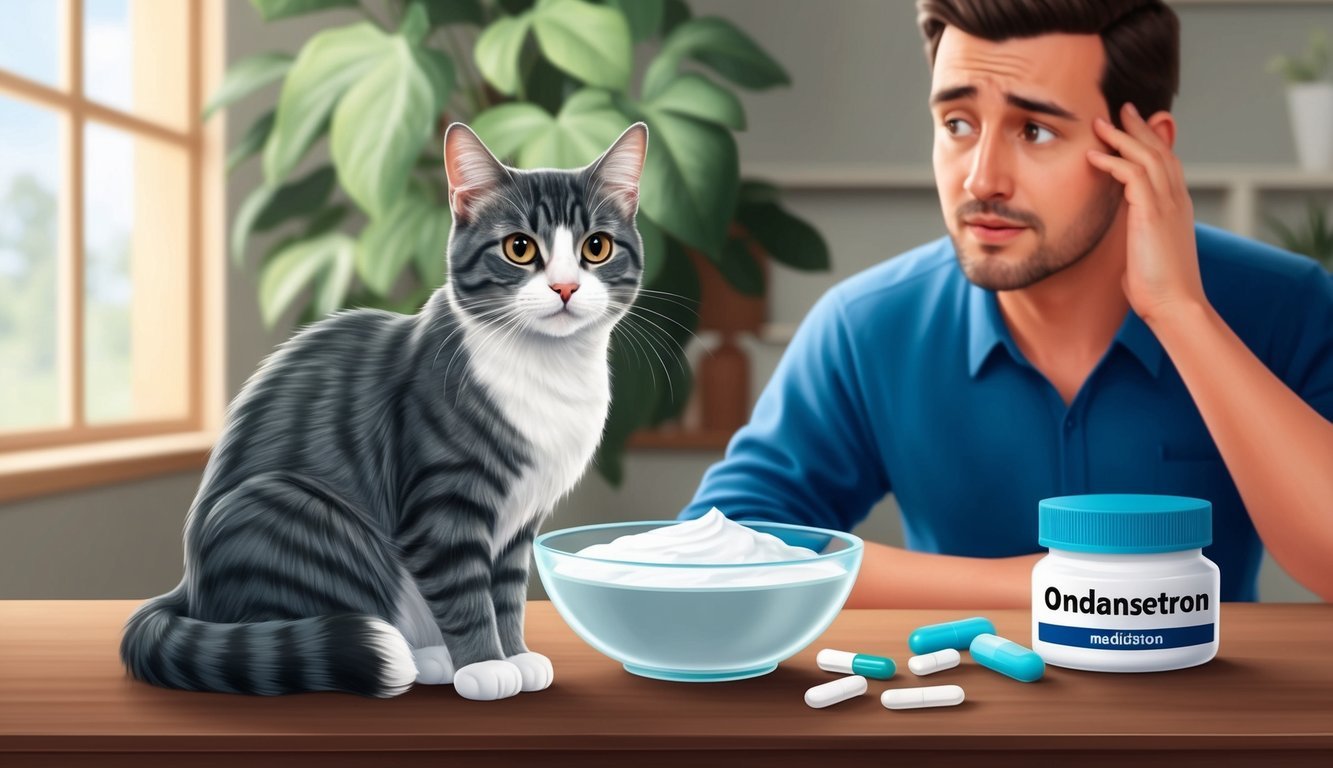
When considering ondansetron for your cat, you might have several questions about dosage, administration, and safety.
Here’s a breakdown of some common queries to help you navigate this medication effectively.
What’s the correct dosage of ondansetron for a cat?
The typical dosage of ondansetron for cats is 0.11 mg per pound of body weight, given every 8 to 12 hours.
Your veterinarian may adjust this based on your cat’s specific condition, so it’s important to follow their recommendations closely.
Can you tell me how to administer ondansetron to a feline?
Ondansetron can be given to cats in tablet or liquid form.
If using tablets, make sure your hands are dry before handling, especially if they dissolve easily.
You can administer it with or without food, but if your cat vomits when given on an empty stomach, offer future doses with food or a treat.
What are the potential side effects of ondansetron when prescribed to cats?
While ondansetron is generally well-tolerated in cats, it can cause some side effects.
Common issues may include lethargy, constipation, or an increased heart rate.
If you notice any unusual behaviors or symptoms after administering the medication, consult your veterinarian.
Is it okay to give ondansetron to a cat with kidney disease?
Ondansetron can be used in cats with kidney disease, but it should be done under veterinary supervision.
Kidney function can impact how your cat processes medications, so it’s essential to have your vet monitor the situation closely and adjust dosages as needed.
Would you recommend ondansetron or Cerenia for a cat’s nausea?
Both ondansetron and Cerenia (maropitant) are effective anti-nausea medications for cats.
Your vet will help you determine which option is better based on your cat’s specific condition and needs.
Each medication has its own set of indications and potential side effects.
Are there any safe anti-nausea medications for cats besides ondansetron?
Yes, other safe anti-nausea medications are available for cats.
Cerenia is a common alternative, as well as certain antihistamines like diphenhydramine.
Always consult your veterinarian before starting any new medication to ensure it’s appropriate for your cat’s health needs.

